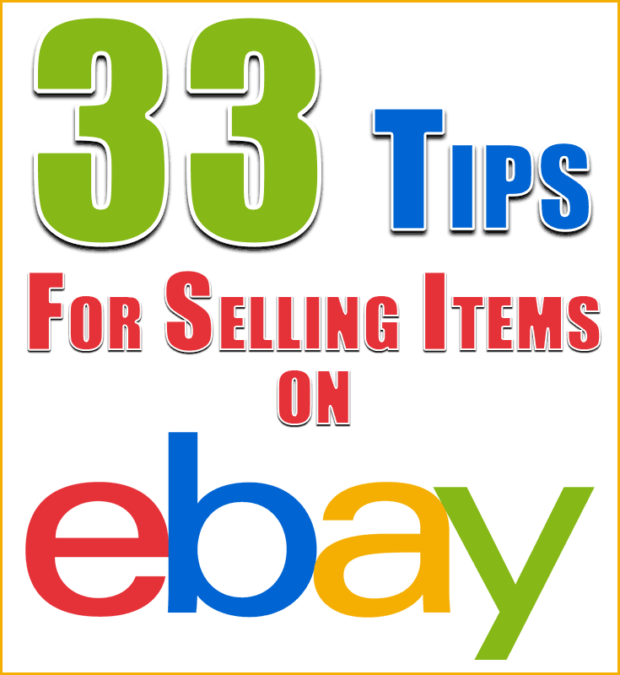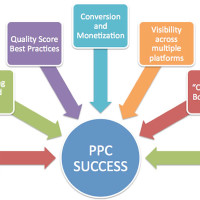eBay provides all the tools necessary to sell or auction of items for either an individual or a business. While it has been around for many years, eBay still remains near the top for selling items on the Web.
While it may seem like an item can sell pretty quickly on eBay, you will face some competition from others that may be selling the same or similar items. To help you sell your items quickly, and for the most money, here are 33 tips for selling items on eBay.

Listing the item
1. Follow eBay’s rules on listings. eBay has rules for listings that you will need to follow. If you don’t adhere to the rules your may find your item removed from eBay or even your account being revoked.
2. Use the right keywords in your listing. Keywords are the key to appearing in both eBay’s and the search engines’ search results. While you shouldn’t get too crazy with your listing title, ensure that you include the manufacturer, item type, size, and color in the description.
3. Don’t use very large words. When describing the item, try to write at an 8th grade level to allow anyone to understand the item. If you use large, complex words that some may not know, you may lose potential customers.
4. Do your reasearch. With the vast amount of information on the Internet it is important to understand exactly what your are selling and how much it is actually worth. While everyone wants to make money, but if you ask too much for an item then it may not sell. On the flip side, if you ask too little, then you are short-changing yourself.
5. Take it as constructive criticism. When listing items on eBay, you will receive feedback – both positive and negative. The key is to take any feedback as constructive as possible. When you reply, be courteous and try to read between the lines of all the negativity and make changes to your listings, if possible.
6. Be as honest as possible. While you may not enjoy adding details about any defects or flaws with your item, it is important to be as honest about the item to potential buyers. It may help to even include photos of the flaws to illustrate your point. This will help buyers understand exactly what they are buying, as well, as perhaps build up reputation for future purchases.
7. Make your listing look professional. Take the time to ensure your listing looks as good as possible. This includes a clear, well-written description, and good photos. Treat your listing as a business – especially if your business relies on selling items on eBay – and get people to trust you.
8. Choose optimal start and end times. According to statistics, most people will be buying on eBay in the evening hours, so it would be wise to start your auction at night. Also, ending your auction at night is also beneficial as that will be when most people will be bidding.
9. Don’t inflate the shipping costs. I can’t tell you how many times I have seen cheap items that cost huge amounts to ship. Don’t list your items for cheap and expect to cover the costs with shipping. This is dishonest, and will get people to distrust you very quickly.
10. Provide clear return policies. Regardless of the product, defects and issues will happen. Ensure that you clearly indicate any return policy, if applicable, in the listing so the bidder knows exactly what to expect if there is a problem with the product.
11. Practice good customer service. The more you list on eBay the more questions or issues could come up. It is important to respond to any question from bidders’ in a timely and courteous manner. Also, if issues in the product do come up, ensure you honor the return policy that you have communicated in your listing.
12. Accept PayPal as payment. While some people may be against using PayPal, when it comes to eBay almost everyone uses PayPal for sending and receiving money. PayPal adds more piece-of-mind to a buyer as they don’t need to worry about sending credit card information to the seller. Plus, using PayPal on eBay allows the buyer to pay for the item in only a few clicks.
13. Encourage feedback from the buyer. eBay is built on reputation and having buyers record positive feedback will go a long way to establishing your eBay account as trustworthy. Trust is everything when selling items on eBay.

Taking pictures of the item
14. Take the time for better photos. When taking photos of your items, don’t just pull out your smartphone and snap a photo. Take the time to properly display your item, and take the best photo possible. Buyers will usually view items that have better photos.
15. Use fill-flash when possible. If you take photos of an item with direct, harsh light, such as outside, then turn on the flash on your camera to fill in the shadow areas. This will reduce the dark shadows and provide more details to your item.
16. Use a digital camera. While smartphones have become popular cameras because of their convenience, a digital camera still provides the best way of taking photos. With digital cameras you can control pretty much all photograph settings, which gives you complete freedom over the final photo.
17. Use a tripod. For the best photos possible, always use a tripod when taking pictures of your objects. This will ensure that the item will be sharp in the photo, helping to create the best photo possible.
18. Use the lowest ISO setting. While a higher ISO setting allows you to take photos with less light, when it comes to the items you list on eBay, you want the best quality photo possible. A lower ISO setting will produce much less noise, better colors and sharper images. Since you should be using a tripod, using the lowest ISO setting on your camera is possible.
19 Take photos of items against a plain background. When taking photos of the items, don’t use a busy or distracting background. For many small items, a simple white or black piece of cardboard will work really well in keepin the focus on the item.
20. Zoom in on the item. If the item has intricate details, take close-up photos of the item to provide the buyer with a good view of the various detail. You may also want to take close-ups of any defects of the item to provide more information to the buyer so they have a better understanding of what you were describing in the listing.
21. Adjust the white balance. For items that are color-specific, don’t just use the auto white balance on the camera as the colors of the item may not be accurate. It would be better to understand how to set the custom white balance on your camera to get the colors as accurate as possible.
22. Learn how to take photos of your items. Tips can only go so far when it comes to taking photos, so learning and understanding how to take pictures is important. For those that are beginners, I recommend Scott Kelby’s Digital Photography Boxed Set . The books are written with beginner’s in mind so it is easy to understand and provides information on taking many different types of pictures.
. The books are written with beginner’s in mind so it is easy to understand and provides information on taking many different types of pictures.

Shipping the item
23. Ship the item quickly. It is important to reduce the amount of time for a bidder to receive the item. While you may not have total control over the item in transit, but you can ensure that you send the item out for delivery as quick as possible. Waiting a few days to ship an item can cause an item to be late for delivery if the bidder wants the item before a specific date.
24. Have shipping supplies on hand. One way to help ship the item quickly is to have the shipping supplies available before the item is even sold. This ensures that you can package the item as quickly as possible and have it sent out for shipping.
25. Take pride in your packaging. When packaging a product, ensure that you use good, strong packaging material to avoid anything from opening during transit. Package the item to ensure that it can’t easily move around and break while it is being shipped and then also provide a packing slip. You may want to even order custom shipping boxes to brand your boxes.
26. Print out the shipping labels from home. eBay provides a convenient way to print out the shipping labels from home. In addition to the shipping label, eBay also allows you to print out the custom forms right at home.
27 Provide insurance for valuable items. If the item you have sold is valuable, provide shipping insurance, if possible. This will give the buyer piece of mind that the item they just purchased is covered in case there is an issue during shipping.
28. Provide tracking information. If at all possible, provide tracking information to the bidder so they can find out where their package is located and the possible date of the package arrival.
29. Generate repeat business on eBay. Include a business card or a thank you note in the package to help remind the buyer where they bought the item and who shipped it quickly.
30. Use delivery confirmation on the package. While you don’t like to think buyers are unscrupulous, but the reality is that there will be some buyers that are like that. By using delivery confirmation, you can be sure that the buyer has received the package to avoid the buyer claiming that they didn’t receive the package.
31. Use signature confirmation for valuable items. For items that are more than $250 you should use signature confirmation, especially if the item was paid using PayPal. The reason for this is that the buyer can claim the item was never received and PayPal will reimburse the money to the buyer.
32. Reuse packaging material. If you are an occasional eBay seller, and don’t have a business on eBay, you should save packaging material (boxes, bubble wrap, etc.) from online orders you receive online. This will save you some money and possible time where you don’t have to go out and buy packaging material.
One final tip:
33. Have fun! You should keep a positive attitude about selling items on eBay and enjoy the process. If you have fun selling items, and hopefully making money too, then it will show in how you list your items and reply to bidders and buyers.














